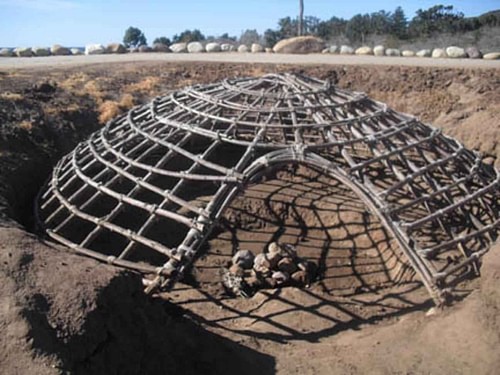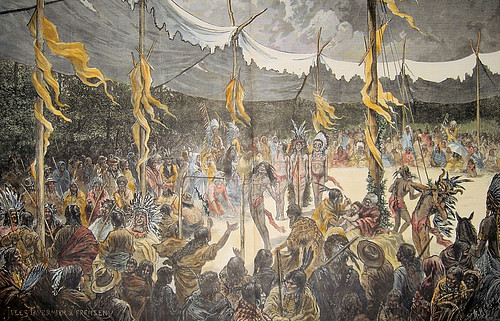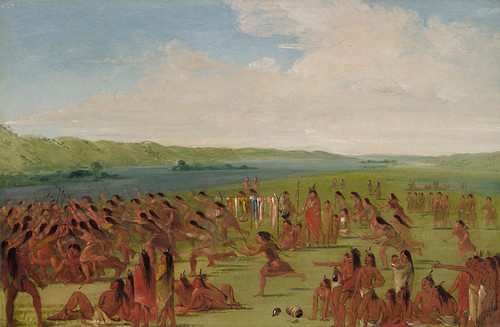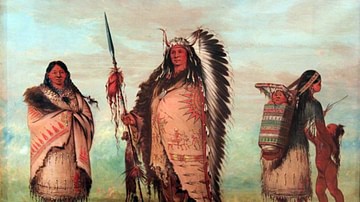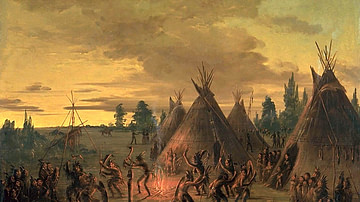The Seven Sacred Rites of the Lakota Sioux (Seven Sacred Rites of the Lakota Oyate) are the spiritual observances of the Native American Sioux nation that maintain their relationship with the Great Mystery/Great Spirit Wakan Tanka, the creative and unifying Higher Power of the Universe. The rites are central to the religious beliefs of the Sioux.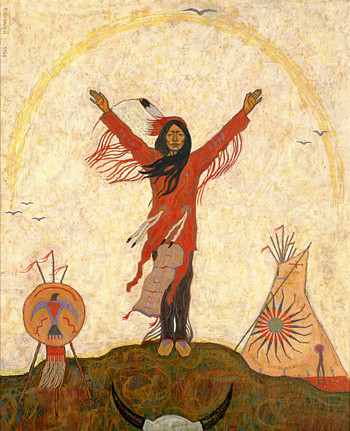
The rituals are understood to have been given to the Lakota Sioux (Lakota Oyate) in the distant past by the supernatural entity White Buffalo Calf Woman, who arrived at a time when the Sioux had lost their connection to the Great Spirit and, so, had lost balance. The seven sacred rites restored that balance and, White Buffalo Calf Woman told them, would maintain it as long as the rituals were observed. The seven sacred rites are:
- Keeping of the Soul (Keeping and Releasing of the Soul)
- The Purification Rite
- Crying for a Vision
- The Sun Dance
- The Making of Relatives
- The Girl’s Coming of Age
- The Throwing of the Ball
Each ritual is considered of equal importance and maintains communion between the people and the Creator, their past, and each other. Native American religious observances, including the seven rites, were outlawed by the government of the United States in the 1890s but continued to be practiced in secret until easements to the laws in the 1920s and 1930s. It was not until 1978, with the passage of the American Indian Religious Freedom Act, that all restrictions on Native American religious observances were lifted.
White Buffalo Calf Woman & The Seven Rites
White Buffalo Calf Woman (Ptesan-Wi) is sometimes referred to as a Native American Goddess or a Divine Spirit but, however she is understood, is recognized as a powerful force of balance and harmony in the universe. At a time when the Sioux had lost their individual and communal balance, the story goes, she appeared to give them the Sioux ceremonial pipe and the seven sacred rites it would be used in. The great Sioux holy man and visionary Black Elk (l. 1863-1950) relates how the seven rites came to the Sioux nation:
The Indians were in camp, and they had a meeting to send scouts out to kill buffalo. The scouts were on top of a hill and, as they looked to north in the distance, something was appearing. They were going on, but they wanted to find out what it was, and they kept looking and finally it came closer; then they found out it was a woman. Then one of the men said: "That is a woman coming." One of them had bad thoughts of her and one of them said: "That is a sacred woman, throw all bad thoughts aside."
She came up the hill where they were. She was very beautiful, her long hair hanging down and she had on a beautiful buckskin coat. She put down what she was carrying and covered it up with sage. She knew what they had in their minds. She said, "Probably you do not know me, but if you wish to do as you think, come."
So the one said to the other, "That is what I told you, but you would not listen to me." So one of the men went and, just as he faced her, there was a cloud that came and covered them. The beautiful woman walked out of the cloud and stood there. Then the cloud blew off and the man was nothing but a skeleton with worms eating on it. That is what happened to him for being bad.
She turned to the other one and said, "You shall go home and tell thy nation that I am coming. Therefore, in the center of thy nation they shall build a big teepee and there I will come" So this man left at once and he was very scared, for his friend was a skeleton.
He told the tribe what had happened, and they all got excited and right away they prepared a place for her to come. They built a teepee right in the center and she was now in it. She put what she was carrying facing the East. All the people gathered right there. She sang a song as she entered the teepee:
"With visible breath I am walking.
A voice I am sending as I walk.
In a sacred manner I am walking.
With visible tracks I am walking.
In a sacred manner I am walking."
Then she presented the pipe to the chief. It was an ordinary pipe but there was a calf carved in one side and there were twelve eagle feathers tied on with a grass that never breaks. She said: "Behold this, for you shall multiply with this and a good nation thou shalt be. You shall get nothing but good from this pipe, so I want it to be in the hands of a good man and the good shall have the privilege of seeing it."
This pipe is still in the possession of the Sioux. The first man who kept it was a man by the name of High Hollow Horn. The pipe is handed down from son to son.
She taught them to "keep spirits" and if a man’s son dies, the man keeps a piece of his son’s hair. This woman was really a white buffalo. Thus, the respect for the white buffalo. She told them that, when there was no food, they should offer this pipe to the Great Spirit, and they would know from this pipe when they were going to have trouble. The pipe gets long at certain times, and this means hard times. When it gets short, the times are good.
After she went back, she sang another song. As she went out of the teepee, everyone saw a white buffalo kicking up its hind legs and leaving in a hurry, snorting as it went.
(Black Elk Speaks, 293-295)
According to some versions of the story, all seven rites were given by White Buffalo Calf Woman at this time while, in others (including Black Elk’s), only six were given and the last, the Throwing of the Ball, came later. The order of the Seven Sacred Rites also differs according to the version of the story told or the tribal nation observing them, and, further, the actual meaning of the rites is only known to those who understand the tradition.
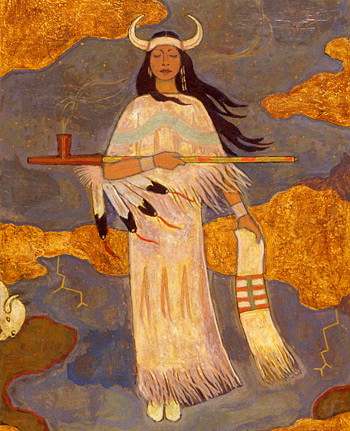
The sacred, as with many civilizations and cultures, is known only to those who have been initiated into the rites while the mundane is allowed to be known to those who do not possess that same level of understanding. The following definitions of the rites, therefore, should be recognized as mundane in that they do not represent the understanding of a Native American raised in their traditions.
Keeping of the Soul
The rite of the Keeping of the Soul (Wanagi Yuhapi) recognizes the eternal nature of the spirit of the individual as well as the concept of fate and how there is a time appointed for one’s death. The most common definition of the Keeping of the Soul states that a "lock of hair" is taken from the deceased, but this "lock" is usually a long braid of hair, not just a strand, that is then wrapped in a "soul bundle" and kept in a special place in one’s home. The person who agrees to "keep the soul" purifies the hair over the smoke of sage or sweet grass and, throughout the time agreed to, honors the soul with offerings and refrains from any behavior that might dishonor the memory of the deceased. After the appointed time, usually a year – though it could be longer – the soul of the departed is released in a ritual that allows it to travel the spiritual pathway across the Milky Way to eternity and union with Wakan Tanka. If a soul should be tainted by poor choices made while in the body, it might linger – possibly attempting good deeds for redemption – until it becomes purified and is allowed to proceed on its way to an eternal home. There is no concept of hell or "eternal punishment" in Native American religious thought.
The Purification Rite
The Purification Rite (Inipi) is associated with the Origin of the Sweat Lodge and, in fact, the Native American term inipi ("to live again") is the name given the sweat lodge. The sweat lodge is used to shed physical and non-physical impurities and rid oneself of ignorance and distraction. The lodge is usually a low structure with no windows and only one entrance/exit, often facing east. In the center of the lodge, hot stones are placed in a hole which, when watered, produce the steam that acts as the purifying agent. The ceremonial pipe and tobacco, sage or sweet grass, drums, and the "medicine bag" or "sacred bundle" – a pouch or bag containing potent spiritual items - all play a part in the ritual led by someone chosen by the elders of the Nation who is recognized for their knowledge of the traditions of the people and personal spiritual power. The lodge is understood important in its own right but also as a necessary prerequisite to the rituals of Crying for a Vision and the Sun Dance.
Crying for a Vision
Crying for a Vision (Hanbleceyapi) is the practice of seeking guidance and direction from the spirit world for one’s life and the betterment of the community as a whole. The individual first seeks the advice and counsel of a "medicine man" or "medicine woman" – a holy person – and offers them a pipe filled with tobacco. Native Americans do not inhale the smoke from the pipe but only take it into their mouths and release it to carry prayers up to the Great Spirit. The holy person then directs the seeker to the ritual of the sweat lodge – which the person usually builds on their own – and is purified before going off alone with only a pipe and sacred tobacco, no food or water, to pray for a vision. The vision may come in any number of forms – or may not come at all – but, if it does, the seeker then returns to the sweat lodge to be purified again before telling the vision to the holy person, who helps them interpret and understand the vision’s message.
The Sun Dance
The Sun Dance (Wiwanyang Wacipi) is a ritual observed to reawaken the Earth after winter, give thanks for the sun and the gifts of the Great Spirit, renew the community, and petition the Great Spirit for one’s needs to be met. The focus of the ceremony is on gratitude for what one has received and personal sacrifice in giving back to the Creator. The ritual lasts for at least four days but may go longer and is recognized as a duty of the people, not only in thanking the Great Spirit formally for their lives, family, and community but also the Earth in helping it maintain balance.
A temporary lodge is constructed and participants, who have purified themselves through the sweat lodge, fasting, and refraining from water or sleep, dance around the center pole (or, in the past, had their chests pierced and were suspended from the pole by ropes) to produce visions, which will then be interpreted by a holy person and usually have to do with the good of the community. It usually takes place in June and, of all the sacred rites, is the only one everyone participates in. As with the others, the ceremonial pipe (the chanunpa) and sacred tobacco play a part in the ritual, which also includes singers and drummers. The ritual concludes with the interpretation of visions, feasting, and the dismantling of the lodge except for the center pole which is left standing to commemorate the event. Even though all the sacred rites are regarded as equally important, the Sun Dance holds special significance as a formal act of thanksgiving and communion with the spirit world, the Earth, and the Creator.
The Making of Relatives
The Making of Relatives (Hunkapi) is observed to establish peaceful relationships with others. Participants paint their faces to symbolize rebirth and new beginnings and, through a ritual involving the ceremonial pipe and sacred tobacco, formalize closer relationships with others – usually those of another nation – making them members of one’s family. According to tradition, the ritual was first enacted between the Lakota and Ree People to ensure peaceful coexistence. Black Elk notes that this ritual, joining people as family who were previously regarded as strangers, mirrors the relationship the people have with Wakan Tanka:
In this rite, we establish a relationship on earth, which is a reflection of that real relationship which always exists between man and Wakan Tanka. As we always love Wakan Tanka first, and before all else, so we should also love and establish closer relationships with our fellow men, even if they should be of another nation than ours. (Sacred Pipe, 101)
The precise details of this ritual vary, but the motivation and goal are always the same: to recognize the essential sameness of every human being and the universal membership of all in a single family who should live harmoniously.
The Girl’s Coming of Age
The Girl’s Coming of Age (Isnati Awicalowanpi) is a ritual recognizing and celebrating a woman’s first menstrual period as a sacred event. Black Elk notes:
It is at this time that a young girl becomes a woman, and she must understand the meaning of this change and must be instructed in the duties which she is now to fulfill. She should realize the change which has taken place in her is a sacred thing, for now she will be as Mother Earth and will be able to bear children, which should also be brought up in a sacred manner. (Sacred Pipe, 116)
During this ceremony, a special lodge or teepee is constructed for the young woman who then takes her place inside. She is supposed to make something in the course of the ritual – a belt, a pouch, whatever she fancies – and is expected to complete whatever it is before the ceremony’s end. If she does not complete her project, it is taken as a sign that she will never complete anything else. The ceremonial pipe is used to offer up prayers for the young woman, and sweetgrass is burned for purification. In the past, a buffalo skull was central to the ritual, symbolizing life. It was painted red to suggest earth energy with blue for sky energy, drawing together both in the symbol of life. At the conclusion of the ritual, a great feast is held, and gifts are given to guests by the family of the young woman, representing the gifts they have received freely from Wakan Tanka.
The Throwing of the Ball
The Throwing of the Ball (Tapa Wankayeyapi) is the most enigmatic of the rites only because, after the United States government outlawed Native American religious observances in the 1890s, much of this ritual came to be forgotten, including the sacred songs that were part of it. The rite involved a young girl, a ball, a "court", and four groups of other girls at the four corners of the "court." The girl would take the ball – once made of buffalo hide but now usually beaded – and throw it to the group to the west where it would be caught and returned to her. She would then throw it to the east, north, and south, and each time it would be caught and returned to her. She would then throw it directly up into the air and catch it. The girl represents purity and the ball Wakan Tanka. By throwing the ball to the four directions, the girl symbolically recognizes the presence of Wakan Tanka everywhere, and by catching it at the end, she receives the Creator’s blessings and, by extension, so do all the other participants and their people.
According to Black Elk, the original game was significantly different from the game played in his time. There seems to have also been (or still is) a version of this ritual where, in the end, the girl rolls the ball to the center of the "court" and whichever way it goes – right or left – is supposed to predict the sex of her first-born child.
Conclusion
After the Wounded Knee Massacre in 1890, during which the US Army killed over 250 Sioux men, women, and children, the United States government sought to further break the people’s spirit and cultural unity by outlawing their religious observances. Even though, as noted, many continued to perform the rituals in secret and keep the language alive, some aspects – like the songs in the Throwing of the Ball – were lost. As Black Elk observes, regarding the Throwing of the Ball:
There are only a few of us today who still understand why the game is sacred, or what the game originally was long ago, when it was not really a game, but one of our most important rites. (Sacred Pipe, 127)
Since the mid-20th century, however, and more so since the 1978 passage of the American Indian Religious Freedom Act, the Sioux – and other Native American nations – have been free to practice their rituals, more or less, as they did in the past for thousands of years, maintaining the balance between themselves, the Earth and its inhabitants, and the Creator.
